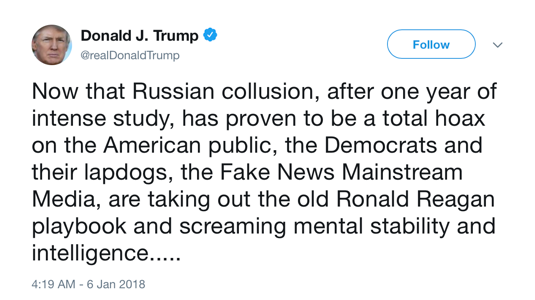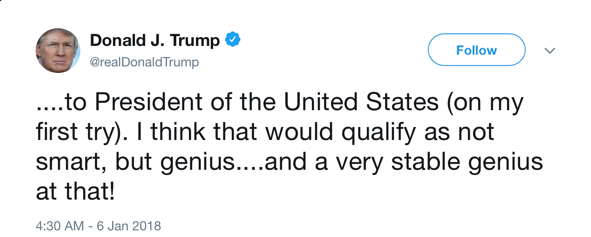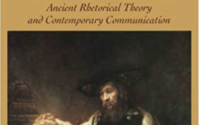Self-Epideictic: The Trump Presidency and Deliberative Democracy
In early January 2018, Michael Wolff published his book, Fire and Fury, which characterizes the Trump White House as inept and chaotic. Following the book’s publication, President Trump was especially defensive. On January 5th, the president tweeted dismissal of Wolff and turned on former chief strategist Steve Bannon, who is quoted in the book as sharply critical of the president:

The next day, Trump turned to critiques from political opponents. Seizing upon salacious claims about the president, many commentators had begun raising questions about his mental fitness. In response, President Trump tweeted the following:



The president’s overstatement is notable since the collusion question had not been disproven. The president’s penchant for such untruths as a rhetorical practice has been discussed by other scholars (Skinnell). Yet, another rhetorical element appears significant here as well: the interjection of self-praise into public deliberations. The president often does this in policy decisions, rebuttals of opponents, and statements on international diplomacy; and descriptions of his own policy proposals are often “tremendous,” “beautiful,” “huge,” and “great.”
Rhetorically, there is more than mere solipsistic self-aggrandizement happening in such cases. Aristotle says that “to praise a man is in one respect akin to urging a course of action” (Kennedy, 1667b35). Aristotle is talking here about the use of epideictic rhetoric, where the praise of a person’s character can create in audiences a desire to emulate praiseworthy (or avoid blameworthy) actions and values. However, President Trump’s political rhetoric often practices what I call self-epideictic—a rhetoric focused on praise of the rhetor’s own character and capabilities. For President Trump, self-epideictic shifts the trajectory of conventional epideictic in such a way that the rhetor becomes a form of argumentative proof. Here I argue that self-epideictic presents challenges to typical values of democratic deliberation and provides the grounds whereby loyalty rhetorics become acceptable deliberative proofs in democratic contexts.
Of course, I do not mean to suggest that President Trump is the only politician to attach celebration to personal ethos. Epideictic rhetorics have been a favorite mode of politicians for literally thousands of years (Harpine; Zoido), and we should expect a measure of self-epideictic in a career that depends on audiences knowing who you are. Rhetoricians have also well-established the concept that epideictic rhetoric can affect more than mere praise or blame: it can ground forensic argument (Palczewkski); play a role in forming public morality (Hauser); and even effect “epideictic forgetting” of social injustices (Vivian). Though certainly not new to human experience, President Trump’s self-epideictic does mark cultural shifts in deliberative styles and argumentative proofs that should be of interest to rhetoricians. The proliferation of self-epideictic may signal changes in how we argue public policy effectively, with a potential chilling effect on democratic deliberation.
Self-Epideictic as Rhetorical Practice
As a practice, self-epideictic complicates classical notions of epideictic genres such as the encomium or funeral oration—occasions where a person’s accomplishments, misdeeds, or death offer an opportunity to praise a person as the expression of shared values with audiences. In that sense, epideictic confirms rather than modifies an exigence, such as in deliberative or forensic rhetoric. As Dale L. Sullivan describes it, epideictic is culturally and politically useful, with “its purpose being the creation and maintenance of orthodox opinions within a culture or subculture” (Sullivan, 117). Self-epideictic forwards and maintains a political orthodoxy organized around the rhetor rather than a shared virtue.
Consider President Trump’s frequent references to crowd size. Crowd size featured prominently in Trump’s self-epideictic in 2016, and it has carried over to his presidential rhetoric, even in instances where it seems ill-suited to the occasion—such as the moment after Hurricane Harvey when, standing before a group of individuals looking for aid, he bragged about crowd size. Yet, crowds love it. In contrast to Aristotelian epideictic rhetoric, where praise of a person’s attributes should confirm the audience’s ethos, large crowds in these instances are taken to confirm Trump’s ethos and, by turn, his political agenda. The president used this line of demonstration in his speech at the 2016 Boy Scout Jamboree when he interjected:
By the way, what do you think the chances are that this incredible, massive crowd, record-setting, is going to be shown on television tonight? One percent or zero? [Applause] “President Trump”—and you know what this is—”President Trump spoke before a small crowd of Boy Scouts today.” That’s some—that is some crowd. [Applause.] Fake media. Fake news. Thank you. And I’m honored that, by the way, all of you people, they can’t even see you. So, thank you. I hope you can hear. (C-SPAN)
Though off-the-cuff in style, Trump’s rhetoric here implicates, and then mobilizes, the audience in defense of the rhetor. As Anna M. Young argues, “Trump’s rallies are a performance of a worldview and an identity—that is, a performance of his style” (32). Rallies are more than rallying the base; they are taken as material enactments of a particular political vision. If crowd size indicates support, then audiences become an embodiment of a political orthodoxy that extends from the rhetor. By turn, as an extension of the rhetor himself, the crowd embodies proof against political opponents—in this case, supposedly unfair media coverage.
Of course, the self-epideictic rhetor runs the risk of coming across as self-centered, which could conflict with other shared values (e.g., humility and selflessness) that also carry resonance in national culture. Since self-epideictic carries so much potential to alienate, rhetors must also circulate it among acceptable notions of character. Though we generally assume that cracks in character damage the overall ethos of a rhetor, self-epideictic insinuates itself into professional and official discourses by dividing the ethos of others, retaining those parts that support the self-epideictic rhetor, and deconstructing those parts that do not. Consider the terse 2017 termination letter given to James Comey, then director of the FBI. After announcing in the first paragraph that he agrees with recommendations to terminate Comey, the president says in the second paragraph:
While I greatly appreciate you informing me, on three separate occasions, that I am not under investigation, I nevertheless concur with the judgement of the Department of Justice that you are not able to effectively lead the Bureau. (Trump)
The first part of the line (“While I greatly appreciate you informing me, on three separate occasions, that I am not under investigation…”) reads as an insertion into another fairly generic line regarding dismissal (“I… concur with the judgement of the Department of Justice, etc.”).
The document offers no reason for termination, indicating that the American public, not Comey, was the intended audience (though the attached memo by Rod Rosenstein does include a rationale). We get instead a self-justification by the president that simultaneously coopts Comey’s ethos as FBI director, where that official position can be used to defend the president, and simultaneously dismisses the person of Comey as unreliable. A part of the self-epideictic rhetor’s work, then, is to hold together between contradictions.
As a rhetorical strategy, such self-epideictic sends a strong signal to other rhetors. Consider the unsuccessful US Senate primary run by Don Blankenship in West Virginia. When President Trump urged voters not to vote for Blankenship, Blankenship did not attack the president. Interestingly, Blankenship attempted to divert the criticism with a split-ethos approach. He responded that the president is “busy” and simply does not know who he is; then Blankenship bragged that he was “Trumpier than Trump” (Gonyea), a split-ethos move that simultaneously deflected criticism as well as coopted Trump’s self-epideictic as a rhetorical proof. Though this proved unsuccessful for Blankenship, it does evince that other rhetors see political opportunities for their own ends in the president’s self-epideictic style.
The self-epideictic rhetor, then, becomes a convenient rhetorical proof for other rhetors—a powerful agent in the pathway from assent to action. After tense negotiations failed at the June 2018 G7 summit in Canada—and following a series of angry tweets by the president in which he called President Trudeau “weak”—White House trade advisor Peter Navarro said:
There’s a special place in hell for any foreign leader that engages in bad faith diplomacy with Donald J. Trump, then stabs him in the back on the way out the door. That’s what bad-faith Justin Trudeau did with that stunt press conference. That’s what weak, dishonest Justin Trudeau did. (Parks)
Navarro later apologized for the statement, but the incident does illustrate the rhetorical impacts of President Trump’s self-epideictic. For one, taken on its own, the statement sounds right out of the president’s style guide: strong decrial of political opponents, name-calling (“bad-faith” and “weak, dishonest” as superlatives), stark constructions of in-group and out-group identity, and, importantly, intense defense of the president.
As a self-epideictic rhetor, Trump takes on a kind of crossing guard role: all assent to acceptable positions become expressions of assent to the president; to argue otherwise activates loyalty rhetorics; dissenting rhetors, even those within the same party, are less likely to voice dissent because doing so contradicts the self-epideictic that mobilizes the base; and political opponents are less likely to grant assent where it may otherwise be due because political positions are so tightly bundled with the president’s ethos. As in Navarro’s “special place in hell” statement, the critique is not issue-based; he represents [this] as enough reason to disavow a rhetorical opponent. Rhetorical display of loyalty becomes popular support for programs and policies.
Self-Epideictic and Rhetorical Effect
Aristotelian epideictic served the important purpose of mediating between competing factions in Athenian democracy. Gerard Hauser, for instance, says that “acts of courage and justice are the most laudatory, since they embody virtues that aid the whole community” (14). As such, “Aristotle recognizes the ceremonial occasion as a time for celebrating deeds that transcend partisan factions and selfish interests” (Hauser, 15). On this point, Trump’s use of self-epidecitc diverges most from classical notions of epideictic—a point worthy of note by rhetoricians interested in deliberative democracy. For President Trump, the use of self-epideictic galvanizes partisan lines.
Chaim Pereleman and Lucie Olbrechts-Tyteca argue that epideictic rhetoric occupies a type of “halfway” role between ascent and action:
The existence of an interval, whether long or short, between the time of adherence and the time of the action it was designed to stimulate explains the intervention into the debate, after it has supposedly ended, of values that had been overlooked or played down, or maybe elements that arose after the decision was made. . . [Epideictic] sets out to increase the intensity of adherence to certain values, which might not be contested when considered on their own but may nevertheless not prevail against other values that might come into conflict with them. (49-51; emphasis mine)
In other words, adherence or persuasion is not equivalent to action. Epideictic can usefully mobilize persuasion into action. If we take Perelman and Olbrechts-Tyteca’s “halfway” theory of epideictic seriously, then we might conclude that the self-epideictic rhetor understands this pathway to political action. The self-epideictic rhetor becomes a halfway point between adherence and action that (1) provides a rhetorical proof that can create rhetorical stability between apparent contradictions and (2) makes loyalty to the rhetor into a type of public action (i.e., the rhetor can be trusted to do the work; we just need to work to support his ethos).
That merger of ethos and epideictic has deliberative consequences. As William D. Harpine claims, authoritarian figures have a “suppressing effect” on rhetoric (82), crowding out room for policy argumentation in political contexts. In his analysis of the ancient Egyptian Amarna letters, Harpine argues that “intense power relationships can distort the expression of argument” (81). In these letters, supplicants made their case through praising the character of the king rather than appealing to expertise in matters related to the decision. Harpine says, “writers in this culture were perfectly capable of making quite cogent deliberative arguments when it suited them”; however, in deliberative correspondence with the king, he argues, “Few of these writers seem to care who is right. Rhetors communicate as if the king cannot be persuaded with facts or reasons but only by loyalty, with loyalty proven in the most extreme cases only by outrageous flattery” (82). Extending Harpine’s frame over self-epideictic helps us better account for implications when it becomes a politically resonant rhetorical strategy.
Deliberative rhetorics thrive on two elements in democratic systems: (1) arrival at stasis in policy argumentation, so that rhetors, regardless of political position on an issue, can agree on what is at issue (even if they do not agree on a course of action); and (2) acknowledging political rivals as opponents—that is, they have a legitimate claim to participate in deliberation. Self-epideictic rhetoric, however, imposes constraints on both of those requirements. Intensive adherence to the self-epideictic rhetor confuses and blocks arrival at stasis on issues and fundamentally dismisses political opponents as deficient and unworthy. As a result, loyalty rhetorics become a type of public deliberative style. We see this in Navarro’s statements above and in Blankenship’s willingness to adopt the ethos of the president that had practically sunk his campaign. The self-epideictic rhetor’s ethos becomes the package in which cultural values are embodied and through which they are appealed to. As a result, self-defense or self-praise takes on ultimate importance because the self-epideictic rhetor essentially becomes the proof in deliberative contexts. More pragmatically, the president’s self-epideictic rhetoric focuses rhetorical energies on the executive branch, which has two potential effects: first, it authorizes the executive branch and its actions as synonymous with expression of the popular will; second, it draws attention away from the legislative branch where, in a democratic republic, citizens can apply the most direct pressures to impact policy.
Since the 2016 election, a body of rhetoric scholarship has begun to grow that argues there are serious material and deliberative consequences to this presidency (Mercieca; Skinnell; Skinnell and Murphy). President Trump’s use of self-epideictic is one feature of a political-rhetorical strategy that calls for more serious attention to the presidency’s use of epideictic overall. When such a president praises a person in ways that mirror descriptions of himself (e.g., offering as proof that Putin was “extremely strong and powerful in his denial” of election interference), or when he engages in blame (e.g., calling the free press the “Enemy of the People”), we should ask: where does such a rhetoric focus attention? And, in turn, where does it centralize authority and power?
Works Cited
- C-SPAN. “President Trump Remarks at 2017 National Scout Jamboree.” C-SPAN, 24 Jul. 2017, https://www.c-span.org/video/?431743-1/president-trump-delivers-remarks-2017-national-scout-jamboree. Accessed 8 Aug. 2018.
- Gonyea, Don. “Former Coal CEO Turned Senate Hopeful Don Blankenship Says He’s ‘Trumpier Than Trump.’” National Public Radio, 8 May 2018, https://www.npr.org/2018/05/08/609133392/coal-ceo-turned-senate-hopeful-don-blankenship-says-hes-trumpier-than-trump. Accessed 8 Aug. 2018.
- Harpine, William D. “Epideictic and Ethos in the Amarna Letters: The Witholding of Argument.” Rhetoric Society Quarterly, vol. 28, no. 1, 1998, pp. 81-98.
- Hauser, Gerard A. “Aristotle on Epideictic: The Formation of Public Morality.” Rhetoric Society Quarterly, vol. 29, no. 1, 1999, pp. 5-23.
- Kennedy, George A. Aristotle, On Rhetoric: A Theory of Civic Discourse. 2nd ed, Oxford UP, 2007.
- Mercieca, Jennifer R. “Dangerous Demagogues and Weaponized Communication.” Rhetoric Society Quarterly, vol. 49, no. 3, 2019, 264-279.
- Palczewski, Catherine Helen. “When Times Collide: Ward Churchill’s Use of an Epideictic Moment to Ground Forensic Argument.” Argumentation and Advocacy, vol. 41, no. 3, 2005, pp. 123-138.
- Parks, Miles. “Canada Responds After White House Says Trudeau ‘Stabbed Us In The Back.’” National Public Radio, 10 Jun. 2018, https://www.npr.org/2018/06/10/618677974/white-house-economic-adviser-canadas-trudeau-stabbed-us-in-the-back. Accessed 8 Aug. 2018.
- Perelman, Chaim, and Lucie Olbrecths-Tyteca. The New Rhetoric: A Treatis on Argumentation, University of Notre Dame, 1971.
- Skinnell, Ryan. “What Passes for Truth in the Trump Era: Telling it Like it Isn’t.” Faking the News: What Rhetoric Can Teach Us About Donald J. Trump, edited by Ryan Skinnell, Societas, 2018, pp. 76-94.
- Skinnell, Ryan, and Murphy, Jillian. “Rhetoric’s Demagogue / Demagoguery’s Rhetoric.” Rhetoric Society Quarterly, vol. 49, no. 3, 2019, pp. 225-232 .
- Sullivan, Dale L. “The Ethos of Epideictic Encounter.” Philosophy & Rhetoric, vol. 26, no. 2, 1993, pp. 113-133.
- Trump, Donald J. “Dear Director Comey.” 9 May 2017. https://www.documentcloud.org/documents/3711117-Letters-on-FBI-Director-James-B-Comey-s.html. Accessed 8 Aug. 2018.
- Young, Anna M. “Rhetorics of Fear and Loathing: Donald Trump’s Populist Style.” Faking the News: What Rhetoric Can Teach Us About Donald J. Trump, edited by Ryan Skinnell, Societas, 2018, pp. 21-38.
- Vivian, Bradford J. “Up from Memory: Epideictic Forgetting in Booker T. Washington’s Cotton States Exposition Address.” Philosophy & Rhetoric, vol. 45, no. 2, 2012, pp. 189-212.
- Zoido, Juan Carolos Iglesias. “The Battle Exhortation in Ancient Rhetoric.” Rhetorica: A Journal of the History of Rhetoric, vol. 25, no. 2, 2007, pp. 141-158.
KEYWORDS: Presidential rhetorics; epideictic rhetoric; deliberative rhetoric; deliberative democracy; Donald J. Trump
COVER IMAGE CREDIT: Twitter
Special thanks to Beth Huber and Lori Beth De Hertogh for reading earlier drafts of this article.




 Jonathan L. Bradshaw is an Assistant Professor of English and director of the Writing, Rhetoric, & Critical Studies Program at Western Carolina University. Jonathan earned his Ph.D. in Composition & Rhetoric at Miami University. His research explores the circulation of civic rhetorics as well as Appalachian cultural rhetorics in heritage-based organizations. His work has appeared in scholarly journals such as Rhetoric Society Quarterly, Rhetoric Review, Enculturation: A Journal of Rhetoric, Writing, and Culture and Appalachian Journal. He also publishes for public-facing venues such as The Daily Yonder and Citizen Critics.
Jonathan L. Bradshaw is an Assistant Professor of English and director of the Writing, Rhetoric, & Critical Studies Program at Western Carolina University. Jonathan earned his Ph.D. in Composition & Rhetoric at Miami University. His research explores the circulation of civic rhetorics as well as Appalachian cultural rhetorics in heritage-based organizations. His work has appeared in scholarly journals such as Rhetoric Society Quarterly, Rhetoric Review, Enculturation: A Journal of Rhetoric, Writing, and Culture and Appalachian Journal. He also publishes for public-facing venues such as The Daily Yonder and Citizen Critics.